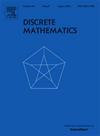On the structure of perfectly divisible graphs
IF 0.7
3区 数学
Q2 MATHEMATICS
引用次数: 0
Abstract
A graph G is perfectly divisible if every induced subgraph H of G contains a set X of vertices such that X meets all largest cliques of H, and X induces a perfect graph. The chromatic number of a perfectly divisible graph G is bounded by where ω denotes the number of vertices in a largest clique of G. A graph G is minimally non-perfectly divisible if G is not perfectly divisible but each of its proper induced subgraph is. A set C of vertices of G is a clique cutset if C induces a clique in G, and is disconnected. We prove that a -free minimally non-perfectly divisible graph cannot contain a clique cutset. This result allows us to re-establish several theorems on the perfect divisibility of some classes of -free graphs. We will show that recognizing perfectly divisible graphs is NP-hard.
论完全可分图的结构
如果G的每个诱导子图H包含顶点集合X,使得X满足H的所有最大团,并且X诱导出一个完美图,那么图G是完全可分的。完全可整除图G的色数以ω2为界,其中ω表示G的最大团中的顶点数。如果G不完全可整除,则图G是最小不可完全可整除的,但它的每个固有诱导子图都是完全可整除的。如果C在G中引起团,且G−C不连通,则G的顶点集C为团切集。证明了无p5的最小不可完全可分图不能包含团切集。这一结果使我们能够重新建立一些关于P5-free图的完全可整除性的定理。我们将证明,识别完全可分图是np困难的。
本文章由计算机程序翻译,如有差异,请以英文原文为准。
求助全文
约1分钟内获得全文
求助全文
来源期刊

Discrete Mathematics
数学-数学
CiteScore
1.50
自引率
12.50%
发文量
424
审稿时长
6 months
期刊介绍:
Discrete Mathematics provides a common forum for significant research in many areas of discrete mathematics and combinatorics. Among the fields covered by Discrete Mathematics are graph and hypergraph theory, enumeration, coding theory, block designs, the combinatorics of partially ordered sets, extremal set theory, matroid theory, algebraic combinatorics, discrete geometry, matrices, and discrete probability theory.
Items in the journal include research articles (Contributions or Notes, depending on length) and survey/expository articles (Perspectives). Efforts are made to process the submission of Notes (short articles) quickly. The Perspectives section features expository articles accessible to a broad audience that cast new light or present unifying points of view on well-known or insufficiently-known topics.
 求助内容:
求助内容: 应助结果提醒方式:
应助结果提醒方式:


